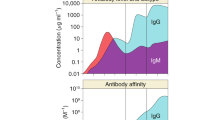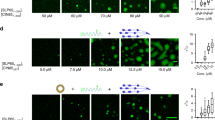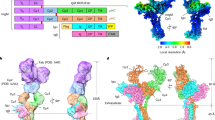Key Points
-
Lipid rafts act as platforms in B cells for B-cell receptor (BCR) signalling and antigen targeting.
-
Rafts concentrate the Src-family kinase Lyn and exclude the BCR and receptors that negatively regulate BCR signalling.
-
BCR oligomerization results in association of the BCR with lipid rafts and its phosphorylation by Lyn, initiating signalling.
-
The association of the BCR with lipid rafts changes during B-cell development, which might contribute to the differences in the outcome of antigen encounter.
-
B-cell co-receptors, including CD19–CD21 and FcγRII influence the association of the BCR with rafts, which might represent a new mechanism for co-receptor function.
-
Epstein–Barr-virus-encoded gene products LMP1 and LMP2A are constitutively associated with rafts and act within rafts to block BCR signalling, providing signals for longevity and inducing latency.
Abstract
The B-cell antigen receptor acts during B-cell activation both to initiate signalling cascades and to transport antigen into the cell for subsequent processing and presentation. Recent evidence indicates that membrane microdomains, termed lipid rafts, have a role in B-cell activation as platforms for B-cell receptor (BCR) signalling and might also act in antigen trafficking. Lipid rafts might facilitate the regulation of the BCR during B-cell development by B-cell co-receptors, and during viral infection. So, lipid rafts seem to be an important new piece of the B-cell signalling puzzle.
This is a preview of subscription content, access via your institution
Access options
Subscribe to this journal
Receive 12 print issues and online access
$209.00 per year
only $17.42 per issue
Buy this article
- Purchase on Springer Link
- Instant access to full article PDF
Prices may be subject to local taxes which are calculated during checkout




Similar content being viewed by others
References
Benschop, R. J. & Cambier, J. C. B cell development: signal transduction by antigen receptors and their surrogates. Curr. Opin. Immunol. 11, 143–151 (1999).
Reth, M. & Wienands, J. Initiation and processing of signals from the B cell antigen receptor. Annu. Rev. Immunol. 15, 453–479 (1997).
Parker, D. C. T cell-dependent B cell activation. Annu. Rev. Immunol. 11, 331–360 (1993).
Wagle, N. M. et al. B lymphocyte signaling receptors and the control of class II antigen processing. Curr. Top. Microbiol. Immunol. 245, 101–126 (2000).
Schamel, W. & Reth, M. Monomeric and oligomeric complexes of the B cell antigen receptor. Immunity 13, 5–14 (2000).
Simons, K. & Toomre, D. Lipid rafts and signal transduction. Nature Rev. Mol. Cell Biol. 1, 31–41 (2000).
Casey, P. J. Protein lipidation in cell signaling. Science 268, 221–224 (1995).
Cheng, P. C., Dykstra, M. L., Mitchell, R. N. & Pierce, S. K. A role for lipid rafts in BCR signaling and antigen targeting. J. Exp. Med. 190, 1549–1560 (1999).First description of the association of the BCR with rafts after crosslinking.
Aman, M. J. & Ravichandran, K. S. A requirement for lipid rafts in B cell receptor induced Ca2+ flux. Curr. Biol. 10, 393–396 (2000).
Weintraub, B. C. et al. Entry of B cell receptor into signaling domains is inhibited in tolerant B cells. J. Exp. Med. 191, 1443–1448 (2000).Evidence that the BCR does not become raft associated in anergic B cells.
Petrie, R. J., Schnetkamp, P. P. M., Patel, K. D., Awasthi-Kalia, M. & Deans, J. P. Transient translocation of the B cell receptor and Src homology 2 domain-containing inositol phosphatase to lipid rafts: evidence toward a role in calcium regulation. J. Immunol. 165, 1220–1227 (2000).
Zipfel, P. A. et al. The c-Abl tyrosine kinase is regulated downstream of the B cell receptor and interacts with CD19. J. Immunol. 165, 6872–6879 (2000).
Kawabuchi, M. et al. Transmembrane phosphoprotein Cbp regulates the activities of Src-family tyrosine kinases. Nature 404, 999–1003 (2000).
Brdicka, T. et al. Phosphoprotein associated with glycosphingolipid-enriched microdomains (PAG), a novel ubiquitously expressed transmembrane adaptor protein, binds the protein tyrosine kinase Csk and is involved in regulation of T cell activation. J. Exp. Med. 191, 1591–1604 (2000).
Guo, B., Kato, R. M., Garcia-Lloret, M., Wahl, M. I. & Rawlings, D. J. Engagement of the human pre-B cell receptor generates a lipid raft-dependent calcium signaling complex. Immunity 13, 243–253 (2000).Shows the constitutive presence of the pre-BCR in lipid rafts during development.
Cheng, P., Brown, B. K., Song, W. & Pierce, S. K. Translocation of the B cell antigen receptor into lipid rafts reveals a novel step in signaling. J. Immunol. 166, 3693–3701 (2001).Evidence that BCR signalling and the actin cytoskeleton are not required for BCR–raft association.
Langlet, C., Bernard, A.-M., Drevot, P. & He, H.-T. Membrane rafts and signaling by the multichain immune recognition receptors. Curr. Opin. Immunol. 12, 250–255 (2000).
Varma, R. & Mayor, S. GPI-anchored proteins are organized in submicron domains at the cell surface. Nature 394, 798–801 (1998).
Schutz, G. J., Kada, G., Pastushenko, V. P. & Schindler, H. Properties of lipid microdomains in a muscle cell membrane visualized by single molecule microscopy. EMBO J. 19, 892–901 (2000).
Pralle, A., Keller, P., Florin, E.-L., Simons, K. & Horber, J. K. H. Sphingolipid–cholesterol rafts diffuse as small entities in the plasma membrane of mammalian cells. J. Cell Biol. 148, 997–1007 (2000).
Brown, D. A. & Jacobson, K. Microdomains, lipid rafts and caveolae. Traffic 2, 668–672 (2001).
Field, K. A., Holowka, D. & Baird, B. Structural aspects of the association of FcɛRI with detergent-resistant membranes. J. Biol. Chem. 274, 1753–1758 (1999).
DeFranco, A. L. The complexity of signaling pathways activated by the BCR. Curr. Opin. Immunol. 9, 296–308 (1997).
Nussenzweig, M. C. Immune receptor editing: revise and select. Cell 95, 875–878 (1998).
Sproul, T. W., Malapati, S., Kim, J. & Pierce, S. K. B cell antigen receptor signaling occurs outside lipid rafts in immature B cells. J. Immunol. 165, 6020–6023 (2000).
Chung, J. B., Baumeister, M. A. & Monroe, J. G. Differential sequestration of plasma membrane-associated B cell antigen receptor in mature and immature B cells into glycosphingolipid-enriched domains. J. Immunol. 166, 736–740 (2001).References 25 and 26 provide evidence that the BCR in immature B cells does not stably associate with lipid rafts.
Saint-Ruf, C. et al. Different initiation of pre-TCR and γδTCR signaling. Nature 406, 524–527 (2000).
Ebert, P. J. R., Baker, J. F. & Punt, J. A. Immature CD4+CD8+ thymocytes do not polarize lipid rafts in response to TCR-mediated signals. J. Immunol. 165, 5435–5442 (2000).
Fearon, D. T. & Carroll, M. C. Regulation of B lymphocyte responses to foreign and self-antigens by the CD19/CD21 complex. Annu. Rev. Immunol. 18, 393–422 (2000).
Dempsey, P. W., Allison, M. E. D., Akkaraju, S., Goodnow, C. C. & Fearon, D. T. C3d of complement as a molecular adjuvant: bridging innate and acquired immunity. Science 271, 348–350 (1996).
Cherukuri, A., Cheng, P. C., Sohn, H. W. & Pierce, S. K. The CD19/CD21 complex functions to prolong B cell antigen receptor signaling from lipid rafts. Immunity 14, 169–179 (2001).Provides evidence that the CD19–CD21 complex prolongs the residence of the BCR in rafts when ligated by complement-coupled antigens.
Ravetch, J. V. & Bolland, S. IgG Fc Receptors. Annu. Rev. Immunol. 19, 275–290 (2001).
Minskoff, S. A., Matter, K. & Mellman, I. FcγRII-B1 regulates the presentation of B cell receptor-bound antigens. J. Immunol. 161, 2079–2083 (1998).
Wagle, N. M., Faassen, A. E., Kim, J. H. & Pierce, S. K. Regulation of BCR-mediated MHC class II antigen processing by FCγRIIB1. J. Immunol. 162, 2732 (1999).
Pearse, R. N. et al. SHIP recruitment attenuates FcγRIIB-induced B cell apoptosis. Immunity 10, 753–760 (1999).
Aman, M. J., Tosello-Trampont, A. C. & Ravichandran, K. FcγRIIB1/SHIP-mediated inhibitory signaling in B cells involves lipid rafts. J Biol Chem. 276, 46371–46378 (2001).Shows that the FcγRIIB functions from within lipid rafts to block BCR signalling.
Bromley, S. K. et al. The immunological synapse. Annu. Rev. Immunol. 19, 375–396 (2001).
Monks, C. R. F., Freiberg, B. A., Kupfer, H., Sciaky, N. & Kupfer, A. Three-dimensional segregation of supramolecular activation clusters in T cells. Nature 395, 82–86 (1998).
Grakoui, A. et al. The immunological synapse: a molecular machine controlling T cell activation. Science 285, 221–227 (1999).
Anderson, H. A., Hiltbold, E. M. & Roche, P. A. Concentration of MHC class II molecules in lipid rafts facilitates antigen presentation. Nature Immunol. 1, 156–162 (2000).Describes the association of the MHC class II molecules with rafts.
Huby, R. D. J., Dearman, R. J. & Kimber, I. Intracellular phosphotyrosine induction by major histocompatibility complex class II requires co-aggregation with membrane rafts. J. Biol. Chem. 274, 22591–22596 (1999).
Batista, F. D., Iber, D. & Neuberger, M. S. B cells acquire antigen from target cells after synapse formation. Nature 411, 489–494 (2001).Describes a membrane structure on B cells that is analogous to the T-cell immunological synapse.
Phee, H., Rodgers, W. & Coggeshall, K. M. Visualization of negative signaling in B cells by quantitative confocal microscopy. Mol. Cell. Biol. 21, 8615–8625 (2001).
Taylor, R. B., Duffus, W. P. H., Raff, M. C. & de Petris, S. Redistribution and pinocytosis of lymphocyte surface immunoglobulin molecules induced by anti-immunoglobulin antibody. Nature New Biology 233, 225–227 (1971). | ISI |
Krummel, M. F., Sjaastad, M. D., Wulfing, C. & Davis, M. M. Differential clustering of CD4 and CD3 during T cell recognition. Science 289, 1349–1352 (2000).
von Haller, P. D., Donohoe, S., Goodlett, D. R., Aebersold, R. & Watts, D. Mass spectrometric characterization of proteins extracted from Jurkat T cell detergent-resistant membrane domains. Proteomics (in the press).
Friedrichson, T. & Kurzchalla, T. V. Microdomains of GPI-anchored proteins in living cells revealed by crosslinking. Nature 394, 802–805 (1998).
Rickinson, A. B. & Kieff, E. in Fields Virology (eds Fields, B. N., Knipe, D. M. & Howley, P. M.) 2397–2446 (Lippincott–Raven, Philadelphia, 1996).
Longnecker, R. & Miller, C. L. Regulation of Epstein–Barr virus latency by latent membrane protein 2. Trends Microbiol. 4, 38–42 (1996).
Caldwell, R. G., Wilson, J. B., Anderson, S. J. & Longnecker, R. Epstein–Barr virus LMP2A drives B cell development and survival in the absence of normal B cell receptor signals. Immunity 9, 405–411 (1998).
Dykstra, M. L., Longnecker, R. & Pierce, S. K. Epstein–Barr virus co-opts lipid rafts to block the signaling and antigen transport functions of the BCR. Immunity 14, 57–67 (2001).Shows that the EBV-encoded gene product LMP2A constitutively resides in rafts and blocks BCR–raft association.
Higuchi, M., Izumi, K. M. & Kieff, E. Epstein–Barr virus latent-infection membrane proteins are palmitoylated and raft-associated: protein 1 binds to the cytoskeleton through TNF receptor cytoplasmic factors. Proc. Natl Acad. Sci. USA 98, 4675–4680 (2001).
Wang, D., Liebowitz, D. & Kieff, E. An EBV membrane protein expressed in immortalized lymphocytes transforms established rodent cells. Cell 43, 831–840 (1985).
Uchida, J. et al. Mimicry of CD40 signals by Epstein–Barr virus LMP1 in B lymphocyte responses. Science 286, 300–303 (1999).
Hostager, B. S., Catlett, I. M. & Bishop, G. A. Recruitment of CD40 and tumor necrosis factor receptor-associated factors 2 and 3 to membrane microdomains during CD40 signaling. J. Biol. Chem. 275, 15392–15398 (2000).
Kaykas, A., Worringer, K. & Sugden, B. CD40 and LMP-1 both signal from lipid rafts but LMP-1 assembles a distinct, more efficient signaling complex. EMBO J. 20, 2641–2654 (2001).
Author information
Authors and Affiliations
Glossary
- ITAM
-
Immunoreceptor tyrosine-based activation motif, which is present in the cytoplasmic domains of the BCR Igα–Igβ complex and becomes tyrosine phosphorylated by Lyn after BCR activation.
- FLUORESCENCE RESONANCE ENERGY TRANSFER
-
A method to determine whether proteins are close to one another by measuring the loss of fluorescence anisotropy between fluorophores that are associated with the proteins.
- SINGLE FLUOROPHORE TRACKING MICROSCOPY
-
A method to measure the lateral motion of a single fluorescently labelled molecule in the plasma membrane using single dye tracking. It yields information about the diffusion and dynamics of individual raft proteins and lipids.
- PHOTONIC FORCE MICROSCOPY
-
A method to measure the local viscous drag of a single membrane protein using a laser trap. It yields information about the size and dynamics of individual rafts.
- ANERGY
-
A state of non-reactivity in B cells that is induced by antigen exposure, commonly in immature B cells
- ITIM
-
Immunoreceptor tyrosine-based inhibitory motif that is present in the cytoplasmic domain of several inhibitory receptors that become tyrosine phosphorylated and recruits the phosphatases SHP1 and SHIP.
- GERMINAL CENTRE
-
A specialized microenvironment in lymph nodes and spleens that forms after antigenic stimulation and is a site of extensive B-cell proliferation and somatic hypermutation of the immunoglobulin genes.
Rights and permissions
About this article
Cite this article
Pierce, S. Lipid rafts and B-cell activation. Nat Rev Immunol 2, 96–105 (2002). https://doi.org/10.1038/nri726
Issue Date:
DOI: https://doi.org/10.1038/nri726
This article is cited by
-
Impact of oligomerization on the allergenicity of allergens
Clinical and Molecular Allergy (2022)
-
Glycerol monolaurate inhibition of human B cell activation
Scientific Reports (2022)
-
Dominant role of splenic marginal zone lipid rafts in the classical complement pathway against S. pneumoniae
Cell Death Discovery (2019)
-
New roles for B cell receptor associated kinases: when the B cell is not the target
Leukemia (2019)
-
Functional link between plasma membrane spatiotemporal dynamics, cancer biology, and dietary membrane-altering agents
Cancer and Metastasis Reviews (2018)



